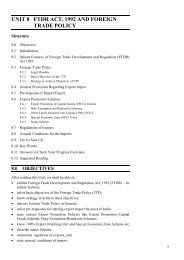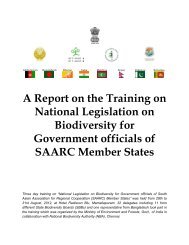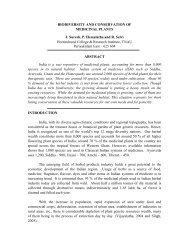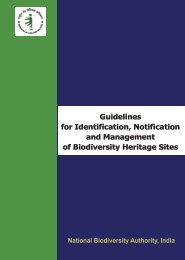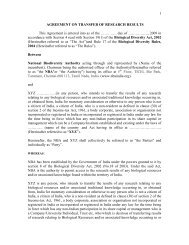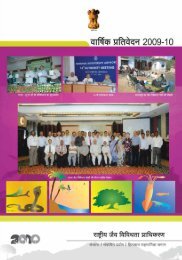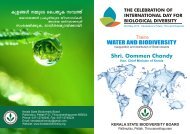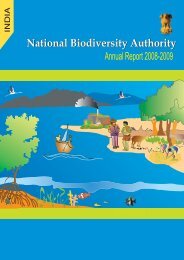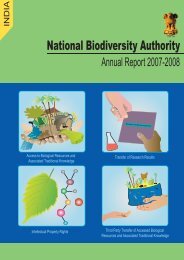BCIL BOOK.pmd - National Biodiversity Authority
BCIL BOOK.pmd - National Biodiversity Authority
BCIL BOOK.pmd - National Biodiversity Authority
Create successful ePaper yourself
Turn your PDF publications into a flip-book with our unique Google optimized e-Paper software.
NATIONAL BIODIVERSITY ACTION PLAN<br />
Act, 1972 authorizes the Chief Wildlife Warden of a<br />
State/UT to permit the translocation/capturing/<br />
killing of a wild animal in the following circumstances:<br />
Schedule-I animals (elephant, tiger, leopard,<br />
etc.) only when they pose threat to human<br />
life or have become so disabled or diseased<br />
beyond recovery; and<br />
Other wild animals (blue bull, wild boar,<br />
monkey, etc.) when they pose threat to human<br />
life, crops and other properties or have<br />
become so disabled or diseased beyond<br />
recovery.<br />
Sacred groves, initiatives of communities for<br />
conserving biodiversity due to their religious beliefs<br />
(India has over 19,000 sacred groves) are also getting<br />
degraded or converted to plantations. Because there<br />
are several medicinal plants and wild relatives of crop<br />
plants occurring naturally in these areas, the sacred<br />
groves need to be conserved. Traditional norms and<br />
practices for conservation of neighbourhood forests<br />
and common land are also diminishing, although<br />
certain rural and tribal communities continue to<br />
safeguard their biological resource base even at the<br />
cost of their livelihood and sustenance (Box 1).<br />
Box 1: Bishnois – Committed to Conservation<br />
The Bishnoi tribe of Western Rajasthan has, over the<br />
centuries, protected the trees and wild animals in and around<br />
their villages. Bishnois do not cut trees for fuel and timber;<br />
they remove only the dead trunks and twigs. Spotted deer,<br />
black buck and blue bull can be seen foraging fearlessly in<br />
their fields. Even if the crop is consumed by herds of deer,<br />
the Bishnois do not chase away the animals.<br />
In 1730 A.D. Maharaja Abhaya Singh of Jodhpur ordered<br />
cutting of trees in large numbers to provide timber<br />
for building a fortress. He sent soldiers to Bishnoi villages<br />
to cut down khejari trees growing in the area. When soldiers<br />
applied the axe, the Bishnoi villagers pleaded to spare<br />
the trees., When the soldiers did not relent, they hugged the<br />
trees and as many as 363 of them laid down their lives to<br />
save the trees.<br />
The Bishnois worship nature in all its manifestations,<br />
conserve trees and medicinal plants, provide food and water<br />
to animals, and are vegetarians in their diet, as advocated<br />
by their Guru Jambaji.<br />
Loss of habitats and over- exploitation have led to<br />
depletion of genetic diversity of several wild animals<br />
and cultivated plants. Shrinking genetic diversity leads<br />
to more vulnerability to diseases and pests and lesser<br />
adaptability to environmental changes. This lesson has<br />
emerged from the world-wide experience of drastically<br />
curtailed genetic diversity in agricultural biodiversity<br />
following the so-called Green and White Revolutions<br />
in agriculture-based economies, including India.<br />
Conserving the flagship large animal species (such<br />
as the lion, tiger, rhino and elephant) has also<br />
highlighted the concern that these projects should aim<br />
at broadening the genetic base (gene pool) in breeding<br />
populations besides focusing on habitat protection.<br />
The decisive factor in saving critically endangered<br />
species is maintaining the minimum size and genetic<br />
base of inter-mating individuals rather than their total<br />
number which may include the non-breeding<br />
individuals also.<br />
An assessment of plant genetic resources for food<br />
and agriculture illustrates this point. These resources<br />
contribute to people’s livelihoods while providing<br />
food, medicine, feed for domestic animals, fibre,<br />
clothing, shelter, energy and a multiple of other<br />
products and services. India is remarkably rich in<br />
agriculturally important genetic resources. However,<br />
both the number of crops grown on commercial scale<br />
and the number of their varieties grown under<br />
different agro-ecosystems, have severely declined in<br />
recent decades reducing thereby the agricultural<br />
biodiversity maintained in diverse farming systems.<br />
About 150 crops feed most of the human<br />
population at present, but just 12 of them provide<br />
80% of food energy (with wheat, rice, maize and<br />
10



